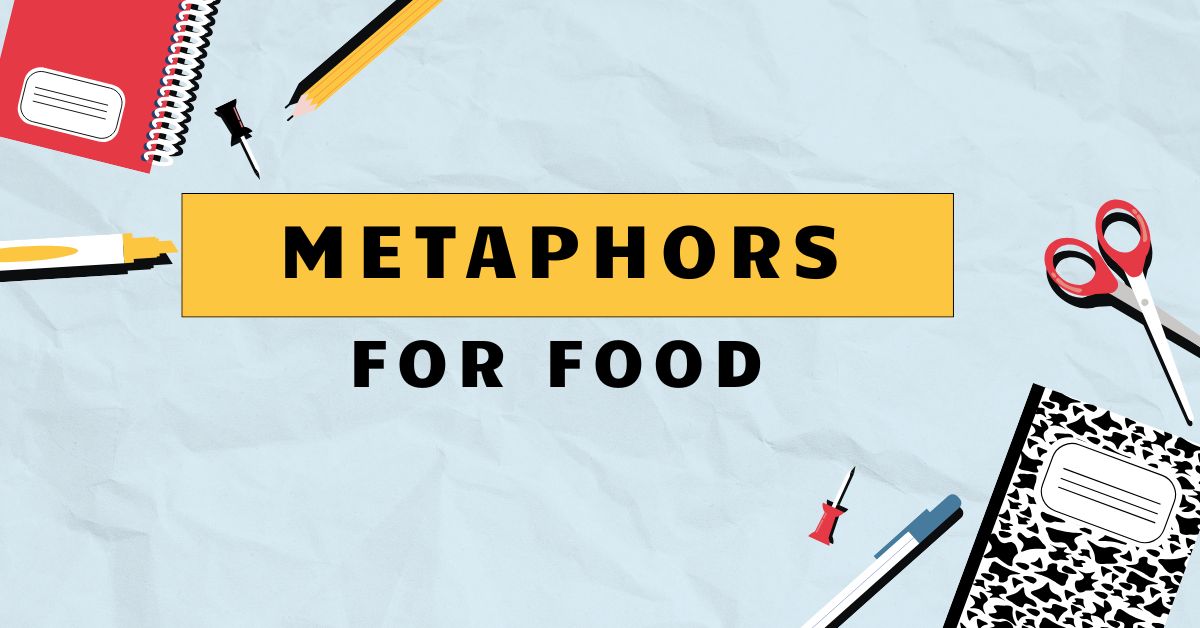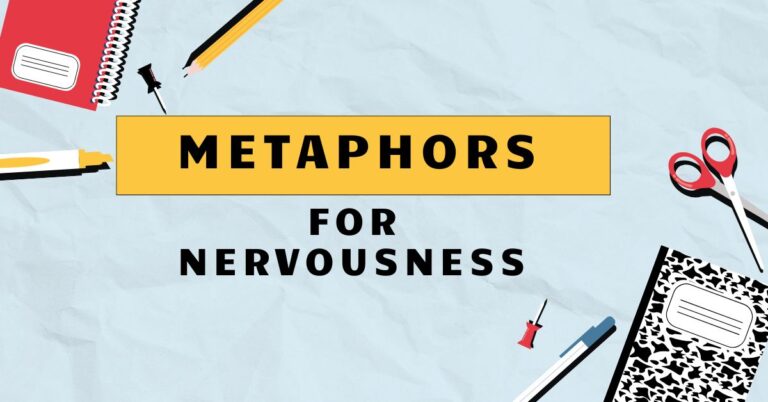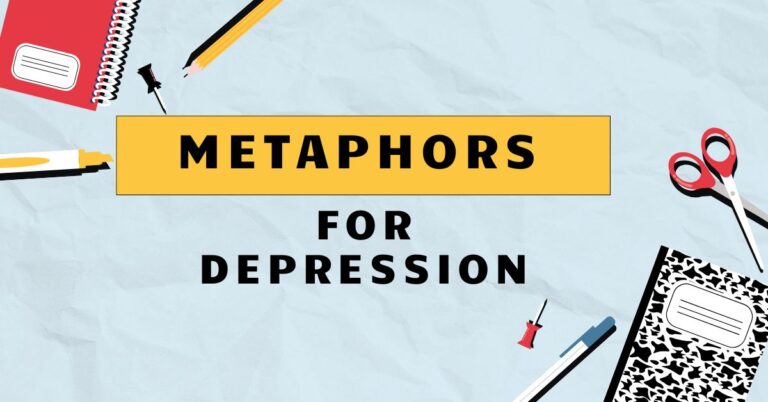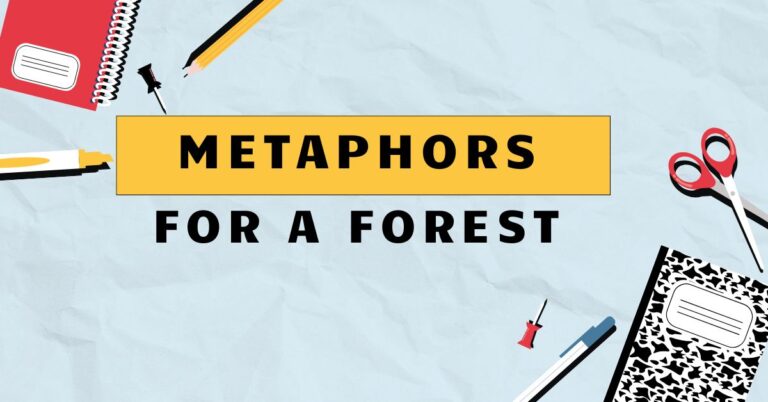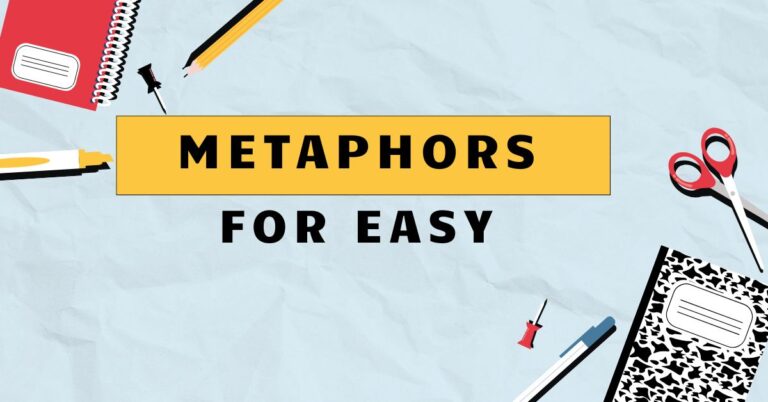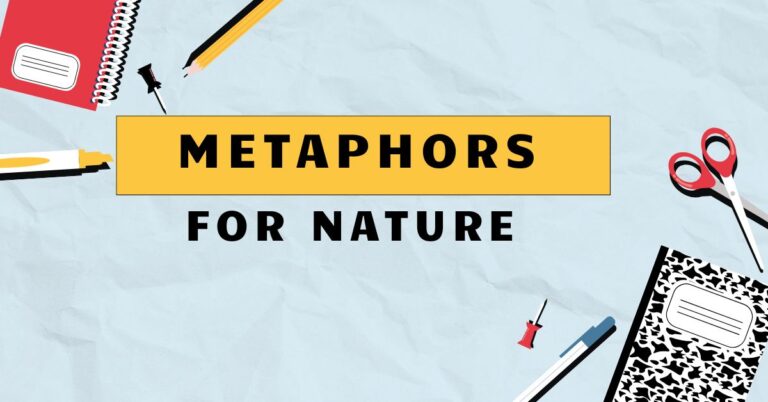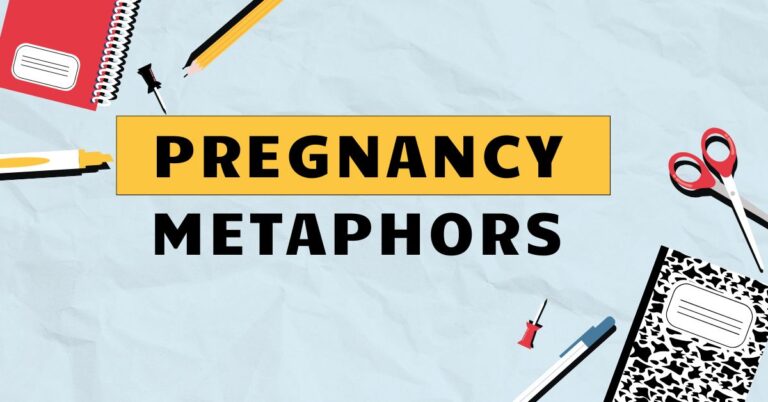49 Metaphors For Food: A Comprehensive Guide to Culinary Language
Metaphors are powerful tools in language, allowing us to understand abstract concepts by relating them to more concrete ideas. Food, being a universal and fundamental aspect of human experience, provides a rich source of metaphorical expressions.
Understanding food metaphors enhances our comprehension of figurative language and adds depth to our communication. This guide explores the diverse world of metaphors for food, examining their structure, usage, and cultural significance.
This article is designed for English language learners, writers, and anyone interested in the art of metaphorical expression.
By mastering food metaphors, you can enrich your vocabulary, improve your writing, and gain a deeper appreciation for the nuances of the English language. Whether you’re a student preparing for an exam, a writer seeking to add flair to your prose, or simply a language enthusiast, this guide offers valuable insights and practical exercises to help you master this fascinating aspect of English grammar.
Table of Contents
- Definition of Food Metaphors
- Structural Breakdown of Food Metaphors
- Types and Categories of Food Metaphors
- Examples of Food Metaphors
- Usage Rules for Food Metaphors
- Common Mistakes with Food Metaphors
- Practice Exercises
- Advanced Topics in Food Metaphors
- FAQ: Frequently Asked Questions
- Conclusion
Definition of Food Metaphors
A metaphor is a figure of speech that directly compares two unlike things without using “like” or “as.” It asserts that one thing *is* another, creating a vivid and often surprising connection. Food metaphors specifically use food-related terms to describe non-food concepts, imbuing them with qualities associated with taste, texture, preparation, or consumption.
These metaphors tap into our sensory experiences with food to illuminate abstract ideas, emotions, or situations.
The function of food metaphors is to make abstract or complex ideas more relatable and understandable. By drawing on our shared experiences with food, these metaphors can evoke strong emotional responses and create a more vivid picture in the listener’s or reader’s mind.
They add color, depth, and nuance to language, making communication more engaging and memorable.
Food metaphors appear in diverse contexts, from everyday conversations to literature, advertising, and even scientific discourse. Their versatility stems from the universality of food as a human experience.
Whether describing a political situation as “a recipe for disaster” or a person as “a tough nut to crack,” food metaphors provide a powerful way to convey meaning and connect with audiences.
Structural Breakdown of Food Metaphors
Food metaphors, like all metaphors, consist of two key elements: the **tenor** and the **vehicle**. The tenor is the subject or concept being described, while the vehicle is the food-related term used to describe it.
The vehicle lends its qualities to the tenor, creating the metaphorical meaning. Understanding this structure is crucial for both interpreting and creating effective food metaphors.
The structure typically involves a verb or adjective associated with food being applied to a non-food subject. For example, in the phrase “He devoured the book,” “book” is the tenor, and “devoured” (a verb associated with eating) is the vehicle.
The act of devouring implies a rapid and enthusiastic consumption, transferring this meaning to the act of reading.
The effectiveness of a food metaphor depends on the strength of the connection between the tenor and the vehicle. A well-chosen vehicle will resonate with the audience and create a clear and evocative image.
Conversely, a poorly chosen vehicle can be confusing or ineffective. Consider the cultural context as well; food metaphors can have different meanings across different cultures.
Types and Categories of Food Metaphors
Food metaphors can be categorized based on the specific aspect of food they draw upon. Here are some common categories:
Texture Metaphors
Texture metaphors use words related to the feel of food to describe non-food concepts. These metaphors often relate to the smoothness, roughness, or consistency of something.
Examples include describing a difficult situation as “sticky,” or a personality as “smooth” or “rough around the edges.”
Taste Metaphors
Taste metaphors use words related to the flavors of food to describe experiences, emotions, or personalities. These metaphors often evoke strong emotional responses.
Examples include describing a victory as “sweet,” a relationship as “bitter,” or a person as “salty.”
Cooking Process Metaphors
Cooking process metaphors use terms related to the preparation of food to describe processes or situations. These metaphors often imply transformation or development.
Examples include describing a plan as “half-baked,” a situation as “stewing,” or an idea as “simmering.”
Dish Metaphors
Dish metaphors use the names of specific dishes to describe situations, people, or events. These metaphors often carry cultural connotations.
Examples include describing a chaotic situation as “a mixed bag,” a simple task as “a piece of cake,” or a complex problem as “a can of worms.”
Spices Metaphors
Spices metaphors use the names or qualities of spices to describe specific qualities or characteristics. These metaphors often add emphasis or flavor to the description.
Examples include describing an event as “spicy,” a conversation as “peppery,” or a personality as “sugary.”
Examples of Food Metaphors
Food metaphors are commonly used in everyday language and literature. The following tables provide a variety of examples, categorized by type, to illustrate their usage and meaning.
The following table provides examples of texture metaphors, showcasing how the physical feel of food can be used to describe abstract concepts.
| Metaphor | Meaning |
|---|---|
| A sticky situation | A difficult or awkward situation to get out of. |
| Smooth operator | Someone who is charming and persuasive. |
| Rough around the edges | Having some imperfections or lacking refinement. |
| A tough nut to crack | A difficult person or problem to deal with. |
| Creamy smooth | Extremely smooth and pleasing. |
| Grainy details | Details that are not clear or precise. |
| Crumbly evidence | Weak or insubstantial evidence. |
| A brittle argument | An argument that is easily broken or refuted. |
| A soft heart | A compassionate and kind person. |
| Hard facts | Undeniable and irrefutable information. |
| A flaky friend | An unreliable or inconsistent friend. |
| A chewy problem | A problem that requires a lot of thought and effort. |
| A velvety voice | A smooth and pleasant voice. |
| A gritty performance | A realistic and determined performance. |
| A mushy love song | An overly sentimental love song. |
| A lumpy explanation | An explanation that is unclear or poorly organized. |
| A dense forest | A forest with thick and impenetrable vegetation. |
| A watery excuse | A weak and unconvincing excuse. |
| A stiff resistance | Strong and unwavering opposition. |
| A pliable mind | A mind that is open to new ideas and suggestions. |
| A silken touch | An extremely gentle and smooth touch. |
| A coarse joke | A vulgar or offensive joke. |
| A stringy argument | A weak and poorly connected argument. |
The following table provides examples of taste metaphors, illustrating how flavors can be used to describe emotions, experiences, and personalities.
| Metaphor | Meaning |
|---|---|
| A sweet victory | A satisfying and enjoyable victory. |
| A bitter disappointment | A painful and unpleasant disappointment. |
| Salty attitude | A sarcastic or cynical attitude. |
| Sour grapes | Pretending to dislike something because you cannot have it. |
| A spicy romance | An exciting and passionate romance. |
| A sugary smile | An insincere or overly sweet smile. |
| A bland personality | A boring or uninteresting personality. |
| A tangy remark | A sharp and witty remark. |
| A nutty idea | A crazy or eccentric idea. |
| A rich experience | A fulfilling and rewarding experience. |
| A tart response | A sharp and critical response. |
| A savory moment | A pleasant and enjoyable moment. |
| A mellow mood | A relaxed and peaceful mood. |
| A pungent criticism | A strong and biting criticism. |
| A juicy story | An interesting and scandalous story. |
| A stale joke | An old and unfunny joke. |
| A zesty performance | An energetic and lively performance. |
| A watered-down version | A weaker or less effective version. |
| A full-bodied argument | A well-developed and persuasive argument. |
| A half-baked idea | An incomplete or poorly thought-out idea. |
| A bittersweet memory | A memory that is both happy and sad. |
| A tasteless remark | An offensive or insensitive remark. |
| A vinegary disposition | A sour and unpleasant disposition. |
The following table provides examples of cooking process metaphors, showing how the actions involved in preparing food can be used to describe other processes or situations.
| Metaphor | Meaning |
|---|---|
| Stewing in anger | Dwelling on and intensifying feelings of anger. |
| Simmering tensions | Underlying tensions that are about to erupt. |
| Cooking up a plan | Creating or devising a plan. |
| Bake sale | A sale of baked goods to raise money. |
| Half-baked scheme | A poorly thought-out or impractical scheme. |
| Boiling point | The point at which someone loses their temper. |
| Recipe for disaster | A situation likely to lead to negative outcomes. |
| Well-seasoned traveler | An experienced and knowledgeable traveler. |
| Marinating on an idea | Thinking about an idea over a period of time. |
| Firing up the grill | Getting ready to start something with enthusiasm. |
| Sifting through information | Carefully examining and evaluating information. |
| Churning out ideas | Producing a large number of ideas quickly. |
| Deep-fried stereotype | An overused and exaggerated stereotype. |
| Slow-cooked success | Success that is achieved gradually over time. |
| Left to simmer | Left to develop slowly over time. |
| Whipped into a frenzy | Excited or agitated to a high degree. |
| Served up on a platter | Presented easily and conveniently. |
| A pinch of salt | To not take something too seriously. |
| Cut and dried | Completely settled or decided. |
| Frying pan to the fire | From a bad situation to a worse one. |
| Cream of the crop | The best of a group. |
| A recipe for success | A set of ingredients or actions that will lead to success. |
| Going to pot | Deteriorating or declining. |
The following table showcases dish metaphors, illustrating how the names of specific foods can be used to describe various situations and people.
| Metaphor | Meaning |
|---|---|
| A piece of cake | Something that is very easy to do. |
| A can of worms | A complex and troublesome situation. |
| Mixed bag | A collection of things that are good and bad. |
| Full of baloney | Full of nonsense or lies. |
| Gravy train | An easy and profitable situation. |
| Hot potato | A controversial or sensitive issue. |
| Bread and butter | One’s basic or essential source of income. |
| Cool as a cucumber | Calm and composed, especially in a difficult situation. |
| Peaches and cream | Smooth and pleasant. |
| Apple of my eye | Someone who is cherished and loved. |
| Second banana | A subordinate or less important person. |
| Big cheese | An important or influential person. |
| Tough cookie | A strong and resilient person. |
| Two peas in a pod | Very similar or compatible people. |
| Egghead | An intellectual or scholarly person. |
| Nut case | A crazy or eccentric person. |
| Cheesecake | Glamorous photographs of women. |
| Beefcake | Glamorous photographs of men. |
| In a pickle | In a difficult situation. |
| Spill the beans | Reveal a secret. |
| Bring home the bacon | To earn a living. |
| Eat humble pie | To admit one’s error and apologize. |
| Sell like hotcakes | To sell very quickly and successfully. |
The following table presents spice metaphors, illustrating how the characteristics of spices can be used to describe qualities or situations.
| Metaphor | Meaning |
|---|---|
| Spice up your life | To add excitement or variety to one’s life. |
| Peppery conversation | A lively and spirited conversation. |
| Sugary words | Overly sweet or insincere words. |
| A dash of humor | A small amount of humor added to something. |
| A pinch of luck | A small amount of luck needed for success. |
| Seasoned professional | An experienced and skilled professional. |
| A touch of class | A small amount of elegance or sophistication. |
| Hot-tempered | Easily angered. |
| A salty dog | An experienced sailor. |
| Honey-tongued | Speaking in a flattering or persuasive manner. |
| A bitter pill to swallow | A difficult or unpleasant situation to accept. |
| Adding fuel to the fire | Making a bad situation worse. |
| A taste of reality | An experience that shows the true nature of something. |
| A sprinkle of magic | A small amount of enchantment or wonder. |
| A sprinkle of fairy dust | A small amount of something that makes things better. |
| Sharp as mustard | Very intelligent and quick-witted. |
| A spoonful of sugar | Something that makes a difficult situation easier to accept. |
| A sweet deal | A good or advantageous arrangement. |
| A bitter truth | An unpleasant or painful truth. |
| A savory tale | An interesting or intriguing story. |
| A bland response | An uninspired or unenthusiastic reaction. |
| A spicy rumor | A scandalous or sensational rumor. |
| A nutty professor | An eccentric or unconventional professor. |
Usage Rules for Food Metaphors
Using food metaphors effectively requires careful consideration of context, audience, and intended meaning. While there are no strict grammatical rules, certain guidelines can help ensure clarity and impact.
Firstly, ensure the metaphor is appropriate for the context. A humorous metaphor might be out of place in a serious discussion.
Secondly, consider your audience. A metaphor that resonates with one group may not be understood by another.
Thirdly, be mindful of cultural differences. Food metaphors can have different meanings across cultures.
Consistency is also important. Avoid mixing metaphors within the same sentence or paragraph, as this can create confusion.
For example, avoid saying “He was stewing in a can of worms,” as it combines two separate food metaphors in a nonsensical way. Instead, stick to one metaphor throughout your description.
Finally, consider the intensity of the metaphor. Some food metaphors are relatively mild, while others are more extreme.
Choose a metaphor that accurately reflects the strength of the feeling or idea you are trying to convey. Overusing strong metaphors can diminish their impact, so use them sparingly and strategically.
Common Mistakes with Food Metaphors
One common mistake is using clichés. Overused food metaphors like “a piece of cake” or “a can of worms” can sound unoriginal and predictable.
Try to find fresh and creative ways to express your ideas. Another mistake is mixing metaphors, as mentioned earlier.
This can create confusion and undermine the effectiveness of your writing.
Misunderstanding the cultural connotations of food metaphors is another potential pitfall. Some food metaphors may have different meanings or associations in different cultures.
For example, the expression “eating crow” (admitting one’s mistake) may not be universally understood. Similarly, using food metaphors related to specific regional dishes may not resonate with audiences unfamiliar with that cuisine.
Here are some examples of common mistakes:
| Incorrect | Correct | Explanation |
|---|---|---|
| He was stewing in a can of worms. | He was stewing in his own juices. | Mixing metaphors creates confusion. |
| That’s just a piece of cake in the pudding. | That’s just the icing on the cake. | Combining clichés dilutes their impact. |
| The project was a real bowl of cherries. | The project was a real can of worms. | Using the wrong metaphor for the situation. |
Practice Exercises
Test your understanding of food metaphors with the following exercises. Choose the best food metaphor to complete each sentence.
Exercise 1:
| Question | Answer |
|---|---|
| 1. The negotiation process was a __________, with both sides refusing to compromise. | A bitter pill to swallow |
| 2. Her presentation was __________, captivating the audience from beginning to end. | A spicy dish |
| 3. After years of hard work, their success was truly __________. | A sweet victory |
| 4. Trying to solve that problem is like opening a __________. | A can of worms |
| 5. He approached the challenge with a __________ attitude, ready to face any obstacle. | Salty |
| 6. The new policy was a __________ for many employees, causing widespread dissatisfaction. | Sour grapes |
| 7. The detective __________ through the evidence, searching for clues. | Sifted |
| 8. The relationship was beginning to __________, with constant arguments and disagreements. | Turn sour |
| 9. She always tries to __________ her stories with a bit of humor. | Spice up |
| 10. The company was accused of __________ its profits by hiding them in offshore accounts. | Cooking the books |
Exercise 2:
| Question | Answer |
|---|---|
| 1. Don’t believe everything he says; he’s full of __________. | Baloney |
| 2. Getting that promotion was a __________, and he celebrated with his colleagues. | Piece of cake |
| 3. The project turned out to be a __________, with both good and bad aspects. | Mixed bag |
| 4. The scandal was a __________ for the politician, damaging his reputation beyond repair. | Hot potato |
| 5. The actor was known for his ability to remain __________ under pressure. | Cool as a cucumber |
| 6. The child was the __________ of her grandmother’s eye, receiving all her love and attention. | Apple |
| 7. The team worked hard to __________ the bacon, ensuring the company’s financial stability. | Bring home |
| 8. After making a mistake, he had to __________ and apologize to his colleagues. | Eat humble pie |
| 9. The new product was expected to __________ like hotcakes, generating significant revenue. | Sell |
| 10. The situation was __________, and they had no idea how to resolve it. | In a pickle |
Advanced Topics in Food Metaphors
Exploring the use of food metaphors in literature and poetry can provide deeper insights into their artistic applications. Authors often use food metaphors to create vivid imagery, convey complex emotions, and develop character.
Analyzing these examples can enhance your understanding of the nuances of metaphorical language.
Another advanced topic is the study of food metaphors in advertising and marketing. Advertisers often use food metaphors to create appealing and memorable messages.
By understanding the psychological effects of these metaphors, you can become a more discerning consumer and a more effective communicator.
Finally, consider the role of food metaphors in shaping cultural identity. Food is often deeply intertwined with cultural traditions and values.
Exploring how food metaphors reflect and reinforce these cultural associations can provide a deeper understanding of the relationship between language and culture.
FAQ: Frequently Asked Questions
- What is the difference between a metaphor and a simile?
A metaphor directly equates two unlike things, while a simile uses “like” or “as” to make a comparison. For example, “He is a lion” is a metaphor, while “He is as brave as a lion” is a simile.
- How can I create effective food metaphors?
Start by identifying the qualities you want to convey, then think of food-related terms that evoke those qualities. Consider the context, audience, and cultural connotations of your metaphors.
- Are food metaphors always appropriate?
No. Consider the context and audience before using food metaphors. They may be inappropriate in formal or serious situations.
- Can food metaphors be offensive?
Yes, if they are used insensitively or exploit cultural stereotypes. Be mindful of the potential impact of your words.
- How do food metaphors differ across cultures?
Food metaphors can have different meanings or associations in different cultures. Research the cultural context before using them.
- What are some common food metaphor clichés to avoid?
Avoid overused phrases like “a piece of cake,” “a can of worms,” and “cool as a cucumber.” Try to find more original expressions.
- How can I improve my understanding of food metaphors?
Read widely, pay attention to how food metaphors are used in different contexts, and practice creating your own metaphors.
- What role does context play in understanding food metaphors?
Context is crucial for understanding the intended meaning of a food metaphor. The surrounding words and the overall situation provide clues to the metaphor’s interpretation.
- How can I use food metaphors to enhance my writing?
Use food metaphors to create vivid imagery, convey complex emotions, and add depth to your descriptions. Be mindful of clarity and appropriateness.
- Are there any resources for learning more about food metaphors?
Yes, many online dictionaries and grammar guides provide information about metaphors. Additionally, studying literature and poetry can expose you to a wide range of metaphorical expressions.
Conclusion
Metaphors for food provide a flavorful way to enrich our language and understanding. By connecting abstract concepts with the tangible world of food, we can create vivid imagery, evoke strong emotions, and communicate more effectively.
Understanding the structure, types, and usage rules of food metaphors is essential for mastering this powerful linguistic tool. Exploring the nuances of food metaphors can enhance your writing, improve your communication skills, and deepen your appreciation for the art of language.
Remember to consider the context, audience, and cultural connotations when using food metaphors. Avoid clichés and mixed metaphors, and strive for originality and clarity.
With practice and careful attention, you can harness the power of food metaphors to add depth, color, and flavor to your language. Keep exploring, keep experimenting, and keep savoring the richness of metaphorical expression.

